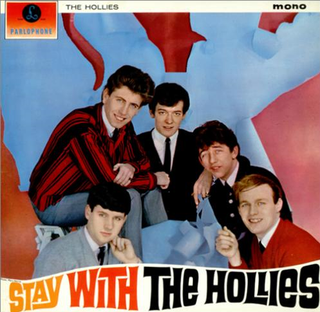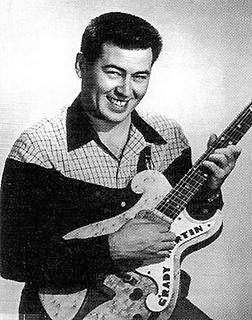Related Research Articles

The Hollies are an English rock and pop band formed in 1962. One of the leading British groups of the 1960s and into the mid-1970s, they are known for their distinctive three-part vocal harmony style. Allan Clarke and Graham Nash founded the band as a Merseybeat-type group in Manchester, although some of the band members came from towns further north, in east Lancashire. Nash left the group in 1968 to form Crosby, Stills & Nash, though he has reunited with the Hollies on occasion.

The Rolling Stones is the debut EP released by the Rolling Stones on 10 January 1964.
Sheldon Talmy is an American record producer, songwriter and arranger, best known for his work in the UK in the 1960s with the Who, the Kinks and many others.

Metamorphosis is the third compilation album of the Rolling Stones music released by former manager Allen Klein's ABKCO Records after the band's departure from Decca and Klein. Released in 1975, Metamorphosis centres on outtakes and alternate versions of well-known songs recorded from 1964 to 1970.
The Vernons Girls were an English musical ensemble of female vocalists. They were formed at the Vernons football pools company in the 1950s in Liverpool, settling down to a sixteen strong choir and recording an album of standards.

In The Hollies Style is the second album by the British rock band the Hollies and was released in November 1964 on Parlophone Records. It missed the official Record Retailer album chart in the United Kingdom, which at the time only had a total of 20 available spots. In Canada, it was released on Capitol in October 1965, with an altered track listing.

Anthony Christopher Hicks is an English guitarist and singer who has been a member of the British rock/pop band the Hollies since 1963, and as such was inducted into the Rock and Roll Hall of Fame in 2010. His main roles within the band are lead guitarist and backing singer.
Paul Young was a British singer and songwriter. He achieved success in the bands Sad Café and Mike + the Mechanics.

Stay with the Hollies, also known by its American release title Here I Go Again, is the debut album by the British rock band the Hollies and was released in January 1964 on Parlophone Records. In Canada, it was released on Capitol in July 1964, with a different track listing. In the US, Imperial Records issued the album under the title Here I Go Again in June 1964 to capitalize on the moderate success of the singles "Here I Go Again" and "Just One Look". It also features covers of well-known R&B songs, not unusual for Beat groups of the day.
The Artwoods were a British rhythm and blues band who formed in 1963 and were professionally active between 1964 and 1967. They were a popular live attraction, rivalling groups such as the Animals, although, despite releasing a clutch of singles and an album, their record sales never reflected this popularity.

Thomas Grady Martin was an American session guitarist in country music and rockabilly.
Alan Charles Klein is an English singer-songwriter and musician. He wrote the soundtrack for the stage play and film, What a Crazy World (1963). In 1964, he released his only solo album, Well at Least It's British, that was re-released in 2008 by RPM Records.

"I'm Gonna Love You Too" is a song written by Joe B. Mauldin, Niki Sullivan and Norman Petty, originally recorded by Buddy Holly in 1957 and released as a single in 1958. It was covered 20 years later by American new wave band Blondie and released as the lead single in the U.S. from their multi-platinum 1978 album Parallel Lines.
Cliff Bennett and the Rebel Rousers were a 1960s British rhythm and blues, soul and beat group who had two top 10 hits with "One Way Love" and "Got to Get You into My Life".
The Luvvers was a Scottish rock group. They are best known as the backing group to Lulu on her debut chart single, "Shout" (1964). They subsequently had a low-key career of their own before disbanding in March 1966.

James Radcliffe was an American soul singer, composer, arranger, conductor and record producer.
Jimmy Powell was a British soul and rhythm and blues singer who recorded and performed throughout the 1960s and early 1970s, and is best remembered as the lead singer of Jimmy Powell and the 5 Dimensions, a group that briefly included Rod Stewart.

"Skinny Minnie" is a 1958 song co-written and recorded by Bill Haley and his Comets. The song was released as a Decca single which became a Top 40 chart hit in the U.S.
The Bo Street Runners were an English R&B band formed in Harrow. England, during 1964. The band released four singles and an extended play record. They gained prominence in the United Kingdom after winning the Ready Steady Win! band contest and included future Fleetwood Mac drummer, Mick Fleetwood and vocalist Mike Patto.
"We Gonna Move to the Outskirts of Town" is a song originally recorded on September 3, 1936, by Piedmont blues musician Casey Bill Weldon. Weldon performed it as a solo piece, with vocals and acoustic guitar plus piano and double bass accompaniment.
References
- 1 2 Bruce Eder. "The Toggery Five – Biography". AllMusic. Retrieved 27 February 2015.
- 1 2 "The Toggery Five 1963–1966". toggery-five.com. Retrieved 27 February 2015.
- ↑ "Paul Young Tribute". houseofmanyrooms.com. Retrieved 27 February 2015.
- 1 2 Olaf Owre. "The Toggery Five story". manchesterbeat.com. Retrieved 27 February 2015.